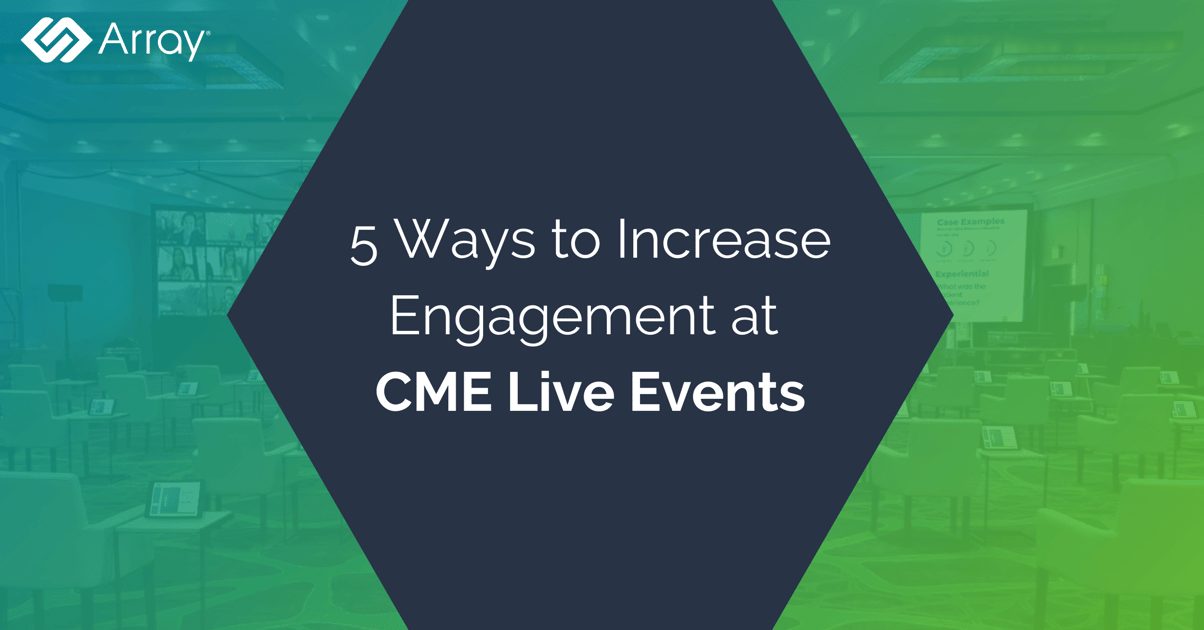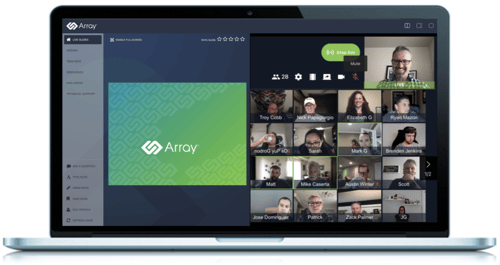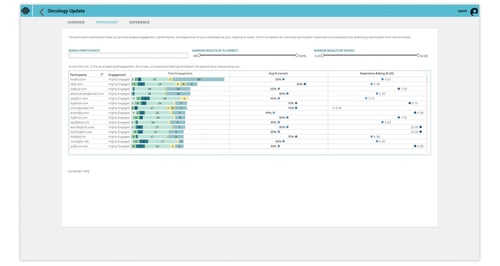5 Ways to Increase Engagement at CME Live Events
January 10, 2022 •Array Team

How well do your continuing medical education (CME) live events engage healthcare professionals? Can you demonstrate impact on knowledge/competence gaps via the data collected at your meetings?
This blog will explore important elements to consider and provide engagement strategies for live CME events.
Major Considerations in Planning CME Events
Many factors go into planning and delivering an effective CME/CE event. Identifying current needs for your audience, collaborating with expert faculty/speakers, and marketing your event for maximum attendance are of course very important. But there are other considerations if you want to to maximize the opportunity for a live CME symposium event
When planning your CME event, you should also consider:
- How you present content: Is your content presented in a compelling, attention-grabbing way?
- Gathering engagement data: How will you collect information about your learners’ experience to demonstrate learning and gain insights to improve future events?
- Your end goals: Is your event designed to align with your objectives?
- Engagement strategies: How will you boost engagement to increase meaningful interactions and improve learning retention?
Without efforts to refine content engagement, and measure and increase interactivity, continuing education events can fall into the boring, age-old structure, with disappointing results. Demonstrating impact and building a dependable brand practitioners flock to for their educational needs rely on constant event improvement based on actionable metrics and insights.
Here are the five ways you can engage learners:
1. Define what success looks like
What does a successful CME event look like to your organization? Your answer may depend on what you’re trying to accomplish and who your attendees are.
CME events should:
- Be relevant to the learners and their practice
- Positively impact learners, care teams, and ultimately patient care
- Support learners in developing the knowledge and skills they can apply and share with to team members
Before your event, consider the data you would hope to have to demonstrate impact.
2. Turn learners into participants
Even today, too often presentations fail to inform and engage because they are planned as sit-down events presenting data from the podium with the audience listening passively.
Here’s a common problems, seen in a 2016 CME study:
“The instructor would go there, without attracting attention...He didn’t care about the audience, just showing his slides. Maybe in around 80% of sessions we attended, we were just listeners.”
- Attendee Feedback, “Improving continuing medical education by enhancing interactivity,” 2016
Sounds familiar?
Involve your learners in an interactive, learner-focused experience. Learners retain more information when they actively engage.
Easy strategies to engage the learner include:
- Polls/Surveys: Gauge opinions on current standards of care, assess how medical professionals would manage patient case scenarios, and test knowledge or competence
- Q&As: Provide an opportunity to engage with the expert faculty
- Gamification: Encourage competition, injects energy and increase active participation
- Resources: Provide slides and other resources so learner can save important information for reference after the event
4. Support improved content quality with event tech
Whether you’re delivering in-person, virtual, or hybrid CME events, you need the right tools to ensure seamless presentation and optimal learner engagement.
Choose the right event technology with the capabilities to complement your instructional design and support your goals for data collection at the event.
5. Track how learners participated and how long they attended
Unlike traditional live events, where you can only measure attendance, event platforms like Array can capture multiple engagement metrics, like participation in discussion and submission of questions, participation in polls, performance in test questions. That means you have the data to demonstrate your learners’ engagement throughout your entire symposium.
6. Power a tailored approach
For a successful CME event, follow-up is key. One of the biggest challenges for CME is the different learner needs across different professions and specialties. Often, it’s hard to provide the exact support each practitioner needs. 
At Array, we provide the tools for you to address this problem by capturing individual engagement data, so you can provide personalized follow-up.
- Pre- and post-test results: Identify continued knowledge gaps for personalized follow-up.
- Saved content and notes: By automatically curating a personalized learning inventory of actions during the event, your learner has a reference which supports their needs after the event.
Conclusion: Make CME Interactive and Learner-Focused
With an interactive and learner-focused approach, powered by the right technology, CME providers can engage diverse learners, and provide smooth, convenient experiences at CME symposia for maximum participation and results. What’s more, with the appropriate event technology partner, flexible virtual solutions are available. As COVID-19 continues to affect events, it is critical to have options and contingency plans.
Pick the Right Event Technology Platform
With nearly 20 years of experience in virtual, in-person, and hybrid events, Array has helped CME providers achieve over 90% learner engagement at thousands of symposia. With built-in tools for content engagement, as well as aggregate and individual event data for appropriate follow-up, Array enables effective, learner-focused CME events.
See how Array can power more meaningful life science events →



